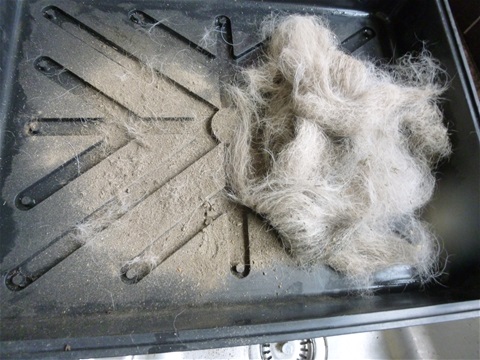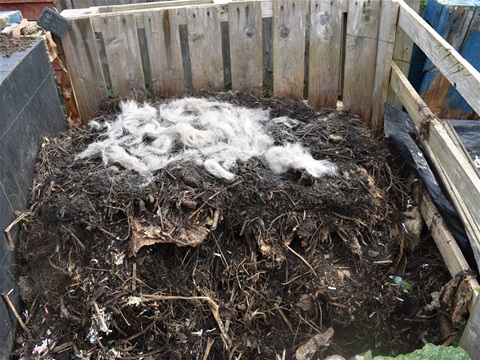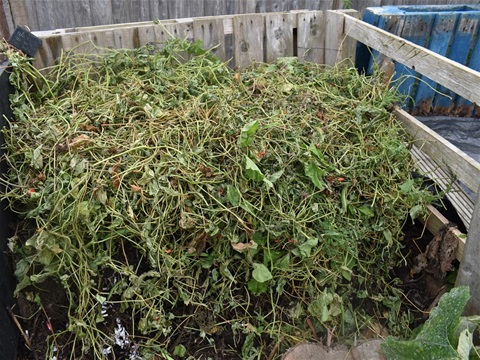Composting Hair
Human hair is usually treated and collected as waste in the landfill waste stream in developed countries . Although some waste hair may be disposed of via the drainage system where it may accumulate and cause blockages. These problems can be avoided as human and pet hair can be home composted. Hair has a high nitrogen content making it a good “Green”, it also contains hydrogen, oxygen, carbon and sulphur according to Rodale this is the same as Bone meal. Modern studies have shown that waste human hair from hair salons mixed with compost is a good source of plant nutrients.
As is the case with many composting procedures we find that they were can be traced back to traditional Chinese agriculture. (http://www.carryoncomposting.com/142941469.
The technique involved the mixing of human hair with cattle dung to create a compost . In India hair was also used to make fertilisers as well as being directly applied to the soil. Direct application has advantages over composting as the composting process can result in some of nitrogen but is not suitable for the average garden. Making l compost (soil improver) commercially in the UK from untreated wool or hair requires registration. More details at: www.gov.uk/government/organisations/animal-and-plant-health-agency/about/access-and-opening#field-services
Composting Hair
Hair decomposes slowly and can form lumps (mat) when being composted unless added to the bin in a small quantity to form a thin layer or mixed with other Greens. It is recommended that the bin is aerated every two or three days for the first week to prevent lumps being formed and to speed the composting process. The more hair being added at any time the more important it is to mix it well to prevent compaction which might reduce air circulation and create anaerobic conditions. Care should be taken not to overload the bin with hair. It should only form a small proportion of the Green material being composted. A compost tumbler may not be as effective as a conventional bin as it has been reported that the hair may not compost completely in the time it takes other material.
Rodale describes a technique for composting hair developed by William Stafford which will deal with larger quantities.
The Stafford recipe uses:
- 10 pounds Hair cut ¾ long,
- 20 pounds of cottonseed meal and
- 11/2 yards of leafmold.
This is mixed and watered and composted for 30-60 days being turned regularly until rotted. It was then used as a mulch round rose bushes.
Environmental writer Janet Harriet quoted on the GRIST website suggests that dyed of bleached hair “may introduce toxic chemicals into your compost,”
Research on the composting of tannery hair waste found that the optimum conditions were:
- temperature 40 - 50 C,
- moisture content 55%,
- pH 7.0 and
- a carbon to nitrogen ratio of 35:1.
As this is the case hot composting will be more effective than cold
Hair can also be used as a feedstock in a wormery dog, human and cat hair is regularly used by home composters. Hair mixed with cattle manure has been used very successfully as a feedstock in the wormery creating compost within a couple of months.
(https://grist.org/green-living-tips/2011-06-27-dirty-blonde-ask-umbra-on-composting-dyed-hair/)
(PDF) Parameters for composting tannery hair waste. Available from:
ttps://www.researchgate.net/profile/Paula_Antunes4/publication/235608138
https://www.gardeningknowhow.com/composting/ingredients/composting-hair.htm
http://www.compostthis.co.uk/hair
Rodale. The complete Book of Composting. Rodale Books
Pet Hair
Hair from pets and other animals can also be composted. Dog hair can be obtained both from home grooming and may make up a considerable proportion of the waste in the vacuum cleaner (I have two Clumber spaniels who shed throughout the year) providing a constant supply of vacuumed hair. The vacuumed waste will include soil and other “dirt” in addition to the pet hair. It is also likely to include human hair and flakes of skin.
Care should be taken vacuuming synthetic carpeting, particularly when new, as this may result the waste in the vacuum containing synthetic fibres which will not break down but will contaminate the compost and soil. For this reason, some argue that it is better for the environment not to make compost from hair vacuumed from modern carpets but to put the waste into the counil residual waste bin.
However, if the contents of the kerbside bin are destined for landfill microplastics are likely to be found in the lechate from the landfill site.
A recent study in which twelve leachate samples from four active and two closed municipal solid waste landfills were investigated microplastics were found in all the landfill leachate samples examined. In total, seventeen different types of plastics were identified in all the samples. Details at https://www.sciencedirect.com/science/article/abs/pii/S004313541930377X
In another study sampling and analysis of microplastics in leachates from a total of 11 landfills in three Nordic countries also found most samples were positive for multiple microplastics. http://www.diva-portal.org/smash/record.jsf?pid=diva2%3A1277395&dswid=-2541
Solid floors e.g. tiles or wooden floors do not present a problem. With dogs that shed hair constantly and the floor or carpet is vacuumed daily the ratio of hair to other dirt is likely to be significant.(see photo)
Some composters may prefer not to compost hair from dogs immediately after they have been treated with a topical flea or worm treatment (normally applied to the back of their neck).
Hair can also be obtained from local hairdressers or dog groomers but do be aware that any waste that comes from a commercial activity may be classified as business waste. It should also be noted that this includes waste produced from running a business from home. See below. (Be aware that Regulations may apply to disposal and carriage of trade waste)
Transport and disposal of Trade waste
The management & disposal of commercial and trade waste and recycling materials is controlled by legislation and ensuring compliance for a small business or when homeworking can be difficult. Basically, all waste produced through work is “Trade Waste”. This will include, in addition to hair, compostable items such as packaging from lunches, discarded food, used teabags and coffee grounds, discarded paperwork, cardboard and packaging, remnants of anything that is produced during the manufacture of goods or delivery of services. In 2010 an environmental aware UK barber was warned that taking home hair clippings from clients' hair to add to his compost was illegal without a licence as it was trade waste. If collected by the council as it would have been sent landfill.
Under the carriage of waste regulations anyone transporting waste as part of their normal business must register for a Waste Carriers Licence. We are seeking advice from the Environmental Agency on the collection and carriage of waste hair and coffee grounds and will add their response when it is received.
However most councils seem to welcome home composters taking spent coffee beans home from cafes etc.
https://www.gov.uk/government/publications/fly-tipping-in-england
https://www.gov.uk/register-waste-carrier/overview



Greer
Hi Thanks for this - just what I needed...
Also just wandering are agapanthus leaves OK for composting? I know they are regarded as toxic.
many thanks
Greer